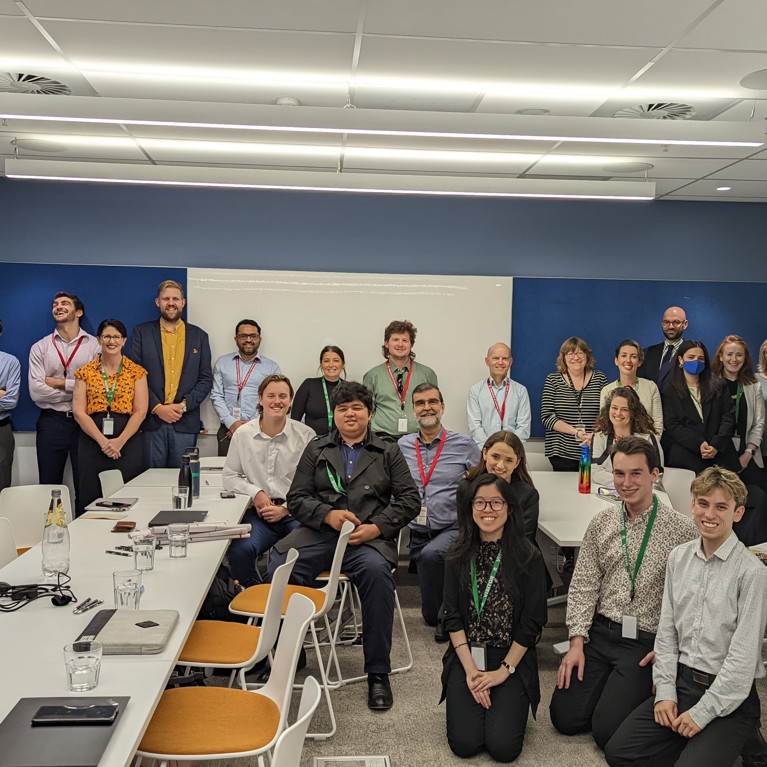- Posted on 19 Jun 2023
- 5-minute read
As workplace health and safety standards continue to evolve, the Centre for Work Health and Safety asked Creative Intelligence and Innovation students to consider “What does it mean to be safe at work?”
When most people hear work health and safety (WHS), they think of personal protective equipment or lifting boxes from the knees. But in reality WHS also covers mental health, bullying, inclusion, culture and physical wellbeing. It protects us all day in, day out.
“I realised that WHS is something that is so overlooked and just dismissed by so many, despite it being such an important issue that affects livelihood. We’re talking about deaths, injuries, mental health in the workplace of many,” said Olivia Wakeling, a final year Creative Intelligence and Innovation (BCII) and law student.
The challenge of keeping Australians safe at work is core to the NSW Centre for Work Health and Safety, who are now dealing with newly introduced AI, robotics, and remote working.
Understanding the complexity of the problem, the Centre for WHS jumped at the opportunity to engage BCII students who were studying the Industry Innovation Project.
A final year subject in the BCII, the Industry Innovation Project runs for 13 weeks. Throughout this time, multidisciplinary student teams tackle real-world complex challenges proposed by industry, community, and government partners.
Industry Innovation Project provides a symbiotic relationship, where we both had a lot to gain. The students gain experience, and we get the fresh ideas – it’s like a breath of fresh air.
Students apply transdisciplinary methods, diverse perspectives, and critical thinking to explore, reframe, and prototype interventions with their industry partner.
“[TD School] is at the forefront of education, because not only do we get to work with a multidisciplinary team, but it gives the students an opportunity to apply these skills to our workplace environment,” said Dr Bill Neto, manager of academic studies at the Centre for WHS.
“Industry Innovation Project provides a symbiotic relationship, where we both had a lot to gain. The students gain experience, and we get the fresh ideas – it’s like a breath of fresh air.”
Advantages of multidisciplinary teams
For the Centre for WHS, one of the most advantageous parts of working with the BCII students was their ability to collaborate.
“Usually, people think alike, right? Even if they are from different academic backgrounds, after working in an institution for a long period of time, they start to think alike and have the same ideas,” said Neto.
“What I found interesting was that these students approached the challenge from different perspectives, and they were able to voice their perspectives and then blend everything together to come up with something useful. It was remarkable.”
Over the course of the project, the students continued to impress Neto and the Centre for WHS with their ability to collaborate, disseminate conflicting perspectives, and manage relationships with executive stakeholders.
“They were very professional,” said Neto.
The Centre for WHS was also impressed with the students’ level of professionalism and how it was demonstrated through their everyday work.
“We tried to dress nice when going into the office. And we improved on our interview skills, asking, ‘How can we make this a mutually beneficial chat?’” said Wakeling.
“We started viewing ourselves as professionals, rather than students.”
Partnering with the Centre for WHS allowed the student team to explore their value to industry. As their first long-term engagement, the students had their first taste of managing a project all the way to the end.
One student, Alexander Galati (BCII and creative writing), remarked that was one of the most beneficial experiences of his education.
“We were invited to a directors meeting. They were treating us as if we’d been working there for months, but it had only been a couple of weeks,” said Galati.
Another student in the team, Travis Radford (BCII and journalism) said it was a highlight of his degree.
“It’s probably one of, if not the very best, experiences I’ve had with an industry partner and with a student team,” he said.
Culture is key
After exploring the problem space, interviewing internal and external stakeholders, and drawing insights on their findings, the student team identified a gap in safe work practices. They identified that when it comes to WHS, there is no one-size-fits-all solution.
The students, based off their exploration, reframed the problem space to look at small businesses and how they could professionalise safe work in the sector. They considered resources, capabilities, and the complexity of reaching the one million small businesses across NSW. But ultimately, they concluded there needed to be a sense of community and belonging.
It’s probably one of, if not the very best, experiences I’ve had with an industry partner and with a student team.
Highlights of getting involved
When asked what the highlight of Industry Innovation Project was, Neto said he was inspired by the way the students worked with each other to design a solution the Centre for WHS can consider implementing it.
“I think the highlight was watching the brainstorming sessions when we would get together every week. What I found remarkable was that it wasn’t one person dominating. Everyone contributed. And I thought that watching the dynamics and the ideas that were being generated – that was the highlight, in my opinion, I really enjoyed it.” said Neto.
The students said the Centre for WHS created an environment where they could explore, question and challenge. The organisation was also receptive to the student TD approaches, welcomed them as equals and valued their insights.
“We weren’t ever treated as students. Everyone really took the project, and us, seriously,” said Radford.
For partners looking to get involved in the Industry Innovation project, Neto said there’s a big return on engaging with these students.
“It’s a worthwhile project. Be mindful that you will be working with the best brains. If you spend time, the return will be a lot brighter,” said Neto.
“You’re dealing with people that can have a positive impact on your organisation. So, if you put in the time, you will get returns.”
Thank you to the Centre for Work Health and Safety and Bill Neto for your commitment to TD School and participation in Industry Innovation Project 2022.
Congratulations to Travis Radford (BCII/ Communication, Journalism), Olivia Wakeling (BCII/ Law), Alexander Galati (BCII/ Communication, Creative Writing), Hamish Cowan (BCII/ Business), Kimberley Ong (BCII/ Forensic Science) and Daniz Abbaspour (BCII/ Engineering) on an exceptional project!






